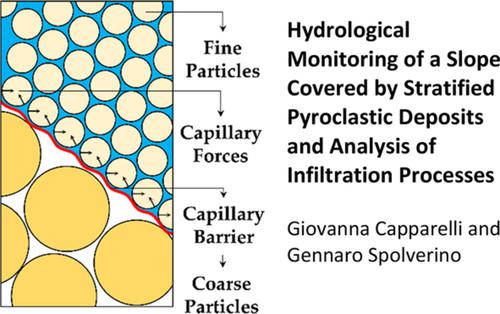当前位置:
X-MOL 学术
›
Hydrol. Process.
›
论文详情
Our official English website, www.x-mol.net, welcomes your
feedback! (Note: you will need to create a separate account there.)
Hydrological monitoring of a slope covered by stratified pyroclastic deposits and analysis of infiltration processes
Hydrological Processes ( IF 2.8 ) Pub Date : 2022-06-09 , DOI: 10.1002/hyp.14634 Giovanna Capparelli 1 , Gennaro Spolverino 1
Hydrological Processes ( IF 2.8 ) Pub Date : 2022-06-09 , DOI: 10.1002/hyp.14634 Giovanna Capparelli 1 , Gennaro Spolverino 1
Affiliation

|
In addition to the duration and intensity of rainfall, infiltration processes are strongly affected by the hydraulic properties of the soil. In the case of heterogeneous and stratified soil profiles, the analysis of the infiltration process becomes more complex, since conflicting hydraulic properties of adjacent layers can induce locally diverted flow. Soils of volcanic origin present these characteristics, because during the various eruptive phases, layers with very different textures are deposited. In this article, data are analysed which have been recorded by a monitoring station installed on a slope made up of volcanic deposits. The station consists of a rain gauge to measure rainfall and seven tensiometers and eight TDR probes installed at different depths to measure suction and volumetric water content, respectively. The slope is made up of alternating volcanic ash (silt-sandy-clay paleosoils) interspersed with pumice (sandy-gravel), due to the different eruptive phases of the volcanic complexes in the area. The analysis of the data established that the layers of coarser material (pumices), depending on the initial moisture conditions, may hinder or even favour the infiltration of water into the deeper layers. In particular, when water content is low, the pumices presented a low unsaturated conductivity which hindered infiltration. By contrast, in wetter conditions, they favoured the flow of water. Therefore, the initial moisture conditions of the soil layers must be taken into account for a correct prediction of the infiltration phenomena. Dry conditions of the pumice layers can hinder drainage into the lower layers, thus favouring the rapid accumulation of soil water during rainfall events, which could eventually lead to slope failure.
中文翻译:

层状火山碎屑沉积物覆盖斜坡的水文监测及入渗过程分析
除了降雨的持续时间和强度外,下渗过程还受到土壤水力特性的强烈影响。在异质和分层土壤剖面的情况下,渗透过程的分析变得更加复杂,因为相邻层的冲突水力特性会导致局部转向流动。火山土壤具有这些特征,因为在不同的喷发阶段,沉积了具有非常不同纹理的层。在本文中,对安装在由火山沉积物组成的斜坡上的监测站记录的数据进行了分析。该站由一个测量降雨量的雨量计和安装在不同深度的七个张力计和八个 TDR 探头组成,分别测量吸力和体积含水量。由于该地区火山杂岩的不同喷发阶段,该斜坡由交替的火山灰(粉砂-砂质粘土古土壤)和浮石(砂质砾石)组成。对数据的分析表明,根据初始湿度条件,较粗糙的材料(浮石)层可能会阻碍甚至有利于水渗入更深层。特别是当含水量低时,浮石呈现出低的不饱和电导率,阻碍了渗透。相比之下,在潮湿的条件下,他们更喜欢水的流动。因此,为了正确预测入渗现象,必须考虑土壤层的初始水分条件。浮石层的干燥条件会阻碍排水到下层,
更新日期:2022-06-09
中文翻译:

层状火山碎屑沉积物覆盖斜坡的水文监测及入渗过程分析
除了降雨的持续时间和强度外,下渗过程还受到土壤水力特性的强烈影响。在异质和分层土壤剖面的情况下,渗透过程的分析变得更加复杂,因为相邻层的冲突水力特性会导致局部转向流动。火山土壤具有这些特征,因为在不同的喷发阶段,沉积了具有非常不同纹理的层。在本文中,对安装在由火山沉积物组成的斜坡上的监测站记录的数据进行了分析。该站由一个测量降雨量的雨量计和安装在不同深度的七个张力计和八个 TDR 探头组成,分别测量吸力和体积含水量。由于该地区火山杂岩的不同喷发阶段,该斜坡由交替的火山灰(粉砂-砂质粘土古土壤)和浮石(砂质砾石)组成。对数据的分析表明,根据初始湿度条件,较粗糙的材料(浮石)层可能会阻碍甚至有利于水渗入更深层。特别是当含水量低时,浮石呈现出低的不饱和电导率,阻碍了渗透。相比之下,在潮湿的条件下,他们更喜欢水的流动。因此,为了正确预测入渗现象,必须考虑土壤层的初始水分条件。浮石层的干燥条件会阻碍排水到下层,











































 京公网安备 11010802027423号
京公网安备 11010802027423号